Your search for 'barrels'
returned
1,183 results.

|
English Durs Egg - London right Percussion Conversion Lock, by L&R
Durs Egg - London right Percussion Conversion Lock Best quality London made flint locks were often converted to percussion, during the 1825 - 1840 transition period. This nice percussion lock has the plate style of an earlier flint lock, with a notch for a 7/16" powder drum and nipple. A fly detent prevents the sear from snagging the half-cock n
|
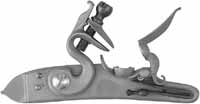
|
John Bailes , right hand flint lock, by L&R
Sometimes called a small Manton, baby Durs Egg, or small English flint lock. This smaller lock is a fine London design, in the style of John Bailes, gunmaker. Correctly used on English pistols, rifles and dainty fowlers of the 1770-1810 period. After about 1780 this improved style of lock is found on American guns, having been smuggled here from En
|
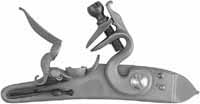
|
John Bailes left hand, flint lock, by L&R
Sometimes called a small Manton, baby Durs Egg, or small English flint lock. This smaller lock is a fine London design, in the style of John Bailes, gunmaker. Correctly used on English pistols, rifles and dainty fowlers of the 1770-1810 period. After about 1780 this improved style of lock is found on American guns, having been smuggled here from En
|

|
S. Hawken left hand, percussion lock, by L&R
Sam Hawken and other makers used these locks on Plains rifles, Ohio rifles and late longrifles, during the later percussion era of 1845 to 1885. Thomas Gibbons of St. Louis made and signed many locks. Note the square inside corner at the front of the lock plate, and the normal narrow percussion hammer, both late features. Fitted with a fly detent f
|

|
English style Queen Anne fowling gun Flint Lock, by L&R
Queen Anne Fowling Gun Flint Lock, by L&R This attractive early English flint lock has a round faced cock and plate, and rounded frizzen and pan surfaces. Ideal for use on early English or American longrifles and fowlers of the 1730 - 1770 era, it will make a fine Chief’s grade trade gun lock, too. Sometimes called a “James Barbar” lock, after t
|
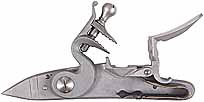
|
American Classic longrifle flint lock , right hand, by L&R
American Classic longrifle flint lock, right hand, by L&R New competition for the Siler lock, L&R’s new “Germanic” lock is for use on classic American longrifles of the 1760-1800 era. It is made to fit large Siler lock mortise. The cam action angle of the tumbler engages the mainspring. This really speeds lock time. Turned bearing surfaces on th
|
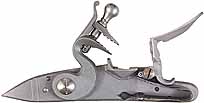
|
American Early Classic longrifle flint lock, no pan bridle, right hand, by L&R
American Early Classic right longrifle Flint Lock, by L&R New competition for the Siler lock, L&R’s new “Germanic” lock is for use on classic American longrifles of the 1760-1800 era. It is made to fit large Siler lock mortise. The cam action angle of the tumbler engages the mainspring. This really speeds lock time. Turned bearing surfaces on th
|
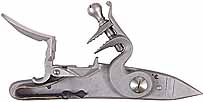
|
American Classic left longrifle Flint Lock, by L&R
American Classic left longrifle Flint Lock, by L&R New competition for the Siler lock, L&R’s new “Germanic” lock is for use on classic American longrifles of the 1760-1800 era. It is made to fit large Siler lock mortise. The cam action angle of the tumbler engages the mainspring. This really speeds lock time. Turned bearing surfaces on the tumbl
|
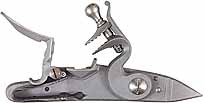
|
American Early Classic left longrifle Flint Lock, by L&R
American Early Classic left longrifle Flint Lock, by L&R New competition for the Siler lock, L&R’s new “Germanic” lock is for use on classic American longrifles of the 1760-1800 era. It is made to fit large Siler lock mortise. The cam action angle of the tumbler engages the mainspring. This really speeds lock time. Turned bearing surfaces on the
|

|
Mule Ear or Sideslapper right hand, percussion lock, by L&R
The L&R Mule Ear or Sideslapper percussion lock design allows the percussion nipple to be mounted directly into the barrel. Pull the hammer outboard to cock the lock. Unlike some mule ear locks this lock has both a half cock and full cock position on the tumbler. The lock plate is 5.1" long by 0.94" tall. The tumbler is fitted with a fly detent to
|
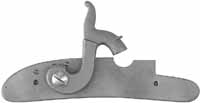
|
Lock, percussion, H.E. Leman Trade Rifle , right hand, by L&R
H. E. Leman, Henry Derringer, and many other Pennsylvania & Ohio rifle makers used this style lock on “trade rifles" sold by merchants and traders to westbound emigrants. Correct for late longrifles and Indian trade rifles of the 1840 to 1880 era. Locks used by Henry Leman's factory often have a distinctive flat tail at the rear of the lock. We lea
|

|
English style Queen Anne Fowling Gun left Flint Lock, by L&R
Fowling Gun Flint Lock, left, by L&R This left hand early English style flint lock has a round faced cock and plate, rounded frizzen and pan surfaces. It matches our right hand lock, and may be used on early double guns. Ideal for use on early English or American longrifles and fowlers of the 1730 - 1770 era. It will make a fine left hand trade
|

|
English Durs Egg - London left Flint Lock, by L&R
Durs Egg - London left Flint Lock Perhaps London’s most innovative lock and gun maker, Mr. Durs Egg immigrated from Switzerland, setting up shop in London, the world’s arms making center in his time. Actually, “Durs” was a nickname, but Mr. Egg adopted it as his own. We are glad he did. Once you have used this lock, you will never confuse the “D
|

|
cock, left, wax cast steel, 1.4" throw, tapped 1/4-28
cock, left, wax cast steel, 1.4" throw, tapped 1/4-28 A fly detent prevents the sear from snagging the half-cock notch when fired. Used with plain or set triggers. Nearly as large as the left Siler lock, it will fit straight or swamped barrels from 3/4" to 1-1/8" octagon at the breech. Notice the "cut away" tumbler and "swing out" link, which great
|

|
frizzen, left, wax cast steel, as cast, temper after fitting
frizzen, left, wax cast steel, as cast, temper after fitting A fly detent prevents the sear from snagging the half-cock notch when fired. Used with plain or set triggers. Nearly as large as the left Siler lock, it will fit straight or swamped barrels from 3/4" to 1-1/8" octagon at the breech. Notice the "cut away" tumbler and "swing out" link, whic
|

|
Mainspring , left, tempered steel, tempered
mainspring, left, tempered steel, tempered A fly detent prevents the sear from snagging the half-cock notch when fired. Used with plain or set triggers. Nearly as large as the left Siler lock, it will fit straight or swamped barrels from 3/4" to 1-1/8" octagon at the breech. Notice the "cut away" tumbler and "swing out" link, which greatly simplify
|

|
plate, left, wax cast steel, .94" x 5.1", tapped 6-40
plate, left, wax cast steel, .94" x 5.1", tapped 6-40 A fly detent prevents the sear from snagging the half-cock notch when fired. Used with plain or set triggers. Nearly as large as the left Siler lock, it will fit straight or swamped barrels from 3/4" to 1-1/8" octagon at the breech. Notice the "cut away" tumbler and "swing out" link, which great
|

|
English Durs Egg - London left Percussion Conversion Lock, by L&R
Durs Egg - London left Percussion Conversion Lock Best quality London made flint locks were often converted to percussion, during the 1825 - 1840 transition period. This nice percussion lock has the plate style of an earlier flint lock, with a notch for a 1/2" powder drum and nipple. A fly detent prevents the sear from snagging the half-cock not
|

|
lock, percussion, H.E. Leman Trade Rifle , left hand, by L&R
H. E. Leman, Henry Derringer, and many other Pennsylvania & Ohio rifle makers used this style lock on “trade rifles” sold by merchants and traders to westbound emigrants. Correct for late longrifles and Indian trade rifles of the 1840 to 1880 era. Locks used by Henry Leman’s factory often have a distinctive flat tail at the rear of the lock. We lea
|

|
Lock, Back Action right hand, percussion, by L&R
Called “back action” because the mainspring hangs behind the tumbler, this lock was popular on percussion guns made in St. Louis, New York, California, Ohio, England and Belgium. Swivel breech double rifles require a back action lock mechanism. This lock can be modified for flint use. Side-by-side or over-and-under double rifles, shotguns, and comb
|
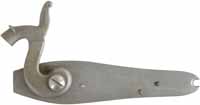
|
Lock, Back Action left hand, percussion, by L&R
Called “back action” because the mainspring hangs behind the tumbler, this lock was popular on percussion guns made in St. Louis, New York, California, Ohio, England and Belgium. Swivel breech double rifles require a back action lock mechanism. This lock can be modified for flint use. Side-by-side or over-and-under double rifles, shotguns, and comb
|

|
Bedford County right hand, flint lock, by L&R
Studying the longrifles of Bedford County, Pennsylvania, might cause you to imagine that time nearly stopped in Bedford County, or that this region was isolated from the world. How can we explain why these men continued to make Bedford County rifles for over 120 years, much later than we might expect? How can we explain these very odd locks, with l
|
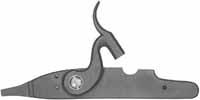
|
Bedford County right hand, percussion lock, by L&R
Studying the longrifles of Bedford County, Pennsylvania, might cause you to imagine that time nearly stopped in Bedford County, or that this region was isolated from the world. How can we explain why these men continued to make Bedford County rifles for over 120 years, much later than we might expect? How can we explain these very odd locks, with l
|
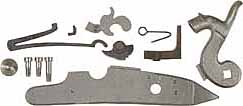
|
Siler large left Percussion Conversion Lock Kit, unassembled
Siler large right Percussion Conversion Lock Kit Siler's large cap lock kit is pre-inlet into some of our most popular stocks. It is designed to fit any 13/16" to 1-1/8" barrel, with a 1/2" diameter powder drum. If you enjoy tinkering with internal lock parts, you will discover that our Siler kit can be assembled into a fine lock. All holes in t
|
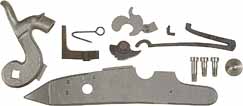
|
Siler Large Right Percussion Lock Kit , unassembled, tempered springs, screws included
Siler large right Percussion Conversion Lock Kit Siler's large right cap lock kit is pre-inlet into some of our most popular stocks. It is designed to fit any 13/16" to 1-1/8" barrel, with a 1/2" diameter powder drum. Ideal for a percussion longrifle, this Germanic style lock has the long pointed tail, raised lock plate with chamfered edges, and
|